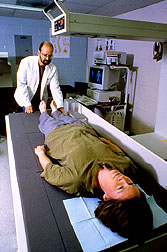What To Expect From Mothers in the Military
|
|
If a female soldier decides to have a child, how quickly will she be ready to return to duty?
Women in the military are expected to maintain a trim appearance. And the military requires all members to pass periodic weight, body fat, and fitness tests. Current military regulations give women 6 months after delivery to meet those requirements. Is that a reasonable expectation?
The U.S. Department of Defense is financing a study at the Children's Nutrition Research Center in Houston, Texas, to learn exactly what women can expect from their bodies before, during, and after pregnancy. It will also address when the military can expect women to return to duty readiness. The research facility is run jointly by Baylor College of Medicine and USDA's Agricultural Research Service.
"This research project, one of the most comprehensive of its kind, will follow 68 military and civilian women's pregnancies," says nutritionist Nancy F. Butte, who leads the study. "Researchers will use the latest scientific tools to assess their calorie needs, body composition, and physical ability."
"Very few studies examine what's happening during pregnancy with this level of complexity, and most do not include pre-pregnancy data," says lactation physiologist Judy M. Hopkinson. "By including before-and-after data, we will be able to see changes that other studies beginning at 8 to 10 weeks of gestation may have missed."
The researchers will be using four component models to estimate body composition. These models combine several different measurements to calculate body fat. Simpler models of body composition use fewer measurements and require more assumptions about the body. But some of those assumptions may not be valid during pregnancy. By combining techniques to measure components of the body, assumptions can be avoided, resulting in greater accuracy.
For example, fat mass and body density can be calculated by hydrodensitometry--that is, by weighing a woman in and out of a tank of water. This technique assumes a certain portion of lean tissue is water--a problem, since the water content of lean tissue increases during pregnancy.
Researchers compensate by adding another test. They give the women water tagged with a safe, nonradioactive form of hydrogen. This allows researchers to measure the total amount of water in the body. By combining data on body density and total body water, they obtain a more accurate estimate of body fat.
Measuring Total Calorie Use
The researchers also use doubly labeled water tagged with nonradioactive forms of both hydrogen and oxygen to make precise measurements of caloric expenditure. The volunteers drink the labeled water, and for 14 days, they provide saliva samples. The rate at which hydrogen and oxygen disappear from the body as water or carbon dioxide gives investigators an estimate of how many calories a woman uses. This works because burning food calories uses oxygen and gives off carbon dioxide.
Each woman spends 24 hours in one of the research center's four state-of-the-art whole-room calorimeters. These look like small hotel rooms complete with television, bed, bathroom, and a treadmill. Such rooms are designed to estimate energy expenditure from very precise measurements of oxygen consumption and carbon dioxide. By comparing data from the doubly labeled water and the calorimeter, scientists can estimate how much energy each woman uses for physical activity.
|
|
Dietitian Caryn Honig completed the study on May 13, 1997, when her second daughter, Natasha, was 6 months old. Honig, 32, works at the Texas Children's Hospital, where she counsels young people with special dietary needs.
"In the first trimester, I burned more calories than in pre-pregnancy; in the second, even more; and in the third, still more," says Honig. "After Natasha was born, I went back to my pre-pregnancy levels--almost to the calorie. For me, this reinforced how important it is to get enough to eat during pregnancy."
The center researchers are also looking at how pregnancy affects body protein, muscle strength, and bone mass. They use dual-energy x-ray absorptiometry (DEXA) before pregnancy and 2 weeks and 6 months after delivery. The instrument provides a three-component (bone, lean tissue, and fat) analysis of the body using safe, ultralow levels of x-rays. To protect the fetus, it's not used during pregnancy. What is learned may help settle some scientific disputes.
"Some studies show bone is lost during pregnancy, but others suggest that it doesn't change--or even increases," says Hopkinson. "We want to look at the net effect of pregnancy on bone mineral content."
But what about protein, the main component of muscle tissue? Researchers measure total body nitrogen, a key part of those proteins, before and just after pregnancy and again 6 months later. Exercise physiologist Margarita Treuth uses a series of strength and exercise tests to obtain a comprehensive picture of the effect of pregnancy and how quickly women return to pre-pregnancy status.
This information will be used to evaluate whether the military's standards for body weight and the requirement for weight gain during pregnancy are compatible.
Determining a Desirable BMI
The military body weight standard is based on a person's body mass index. This is calculated by dividing body weight in kilograms by the square of a person's height in meters. A woman at 5 feet 5 inches can weigh no more than 144 pounds, to meet the military standard of a BMI of 24.
"Pre-pregnancy BMI is a determinant of fetal growth," says Butte. "The recommended weight gain in women with a low BMI (below 19.8) is higher than for women with average or above-average BMIs. But we don't know which part of that compensating gain is benefiting the fetus. Is it gains in fat, free fat mass, or water? It may be there's a threshold for maternal fat below which fetal growth is compromised. That's one reason we need a better physiological model of pregnancy," she says.
The four-component model and the expertise of Butte's research team have already identified an error in the equation the military uses to calculate fat mass. Military equations, based on body circumference measurements, underestimate fat mass. The margin of error in greater in heavier women.
How do the military women feel about this study?
Major Maureen Barthen, 36, a military reservist for 3 years, is at the pre-conception stage. She works at the 75th Army Division in Houston, Texas, evaluating her unit's wartime readiness. At home, she's the mother of 6-year-old Frances and Amelia, a 4-year-old.
"I'm really excited about the study," says Barthen, "I want to learn more about my body's changes in pregnancy. This is not just because I'm in the reserves. Being fit is part of staying healthy."
This research will benefit not only military women like Barthen, but also all women concerned about regaining fitness after their babies are born.--By Jill Lee, Agricultural Research Service Information Staff, 6303 Ivy Lane, Greenbelt, Maryland 20770, phone (301) 344-2781.
Nancy F. Butte and Judy M. Hopkinson are at the Children's Nutrition Research Center, Baylor College of Medicine, 1100 Bates St., Houston, TX 77030-2600; phone
[Butte] (713) 798-7179, fax (713) 798-7187. [Hopkinson] (713) 798-7008, fax (713) 798-7098.
"What To Expect From Mothers in the Military" was published in the April 1998 issue of Agricultural Research magazine. Click here to see this issue's table of contents.








